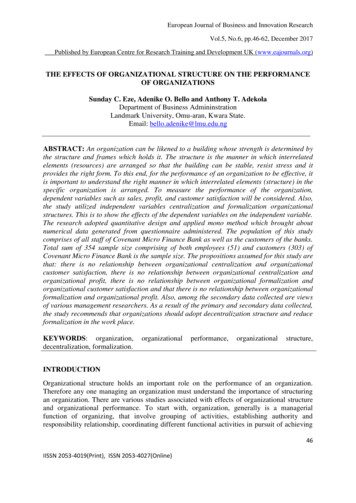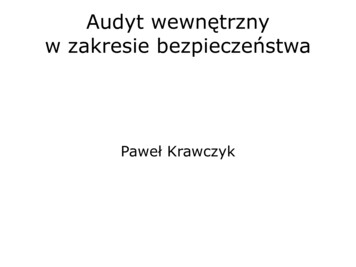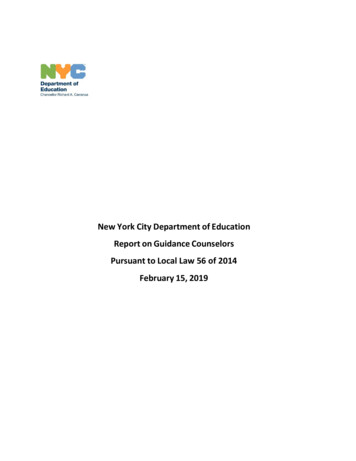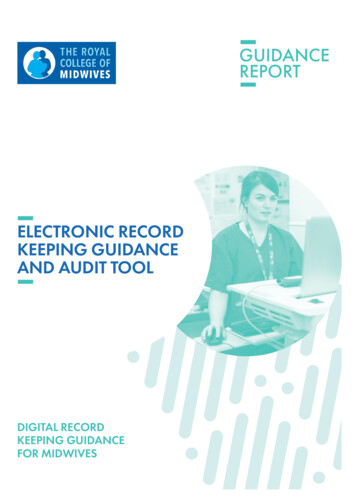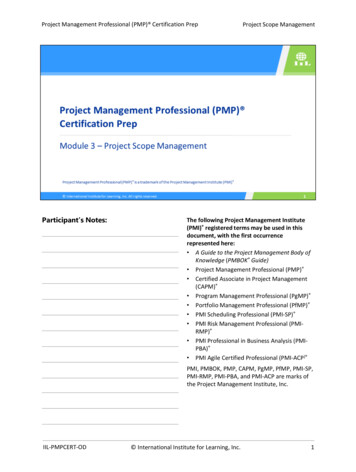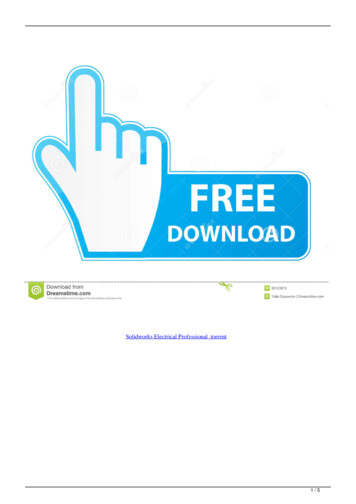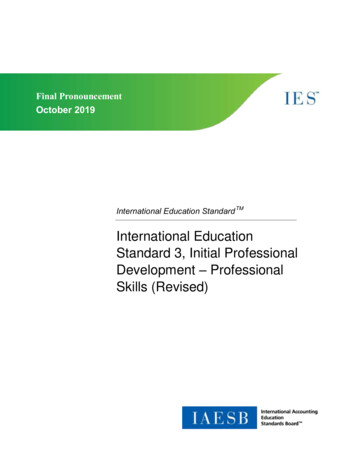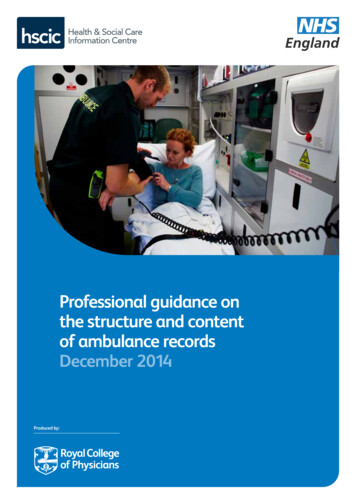
Transcription
Professional guidance onthe structure and contentof ambulance recordsDecember 2014Produced by:
Organisations that endorsed the guidanceAssociation of Ambulance Chief ExecutivesAssociation of Directors of Children's ServicesAssociation of Air AmbulancesBritish Association for Immediate Care (BASICS)British Cardiovascular SocietyBritish Heart FoundationBritish Orthopaedic AssociationBritish Red CrossCare Provider AllianceCollege of Emergency MedicineCollege of Occupational TherapistsCollege of ParamedicsIndependent Ambulance AssociationNational Ambulance Services Medical Directors GroupNational Care AssociationNational VoicesRoyal College of AnaesthetistsRoyal College of General PractitionersRoyal College of NursingRoyal College of Obstetricians and GynaecologistsRoyal College of Paediatrics and Child HealthRoyal College of PsychiatristsRoyal National Lifeboat InstitutionRoyal Pharmaceutical SocietyThe Faculty of Pre‐Hospital Care Health and Social Care Information Centre 20142
The Health and Social Care Information CentreThe Health and Social Care Information Centre (HSCIC) is the trusted national provider of high‐qualityinformation, data and IT systems for health and social care. The HSCIC collects, analyses and publishes nationaldata and statistical information as well as delivering national IT systems and services to support the health andcare system. The information services and products are used extensively by a range of organisations to supportthe commissioning and delivery of health and care services, and to provide information and statistics that areused to inform decision‐making and choice.The Royal College of PhysiciansThe Royal College of Physicians is a registered charity that aims to ensure high quality care for patients bypromoting the highest standards of medical practice. It provides and sets standards in clinical practice andeducation and training, conducts assessments and examinations, quality assures external audit programmes,supports doctors in their practice of medicine, and advises the government, public and the profession onhealthcare issues.NHS EnglandNHS England exists to create the culture and conditions for health and care services and staff to deliver thehighest standard of care and ensure that valuable public resources are used effectively to get the bestoutcomes for individuals, communities and society for now and for future generations. NHS England empowersand supports clinical leaders at every level of the NHS to make genuinely informed decisions. Central to theirambition is to place patients and the public at the heart of everything they do.Citation for this report: Health and Social Care Information Centre, NHS England. Professional guidance on thestructure and content of ambulance records. London: HSCIC, 2014.CopyrightThis document has been prepared by the Royal College of Physicians on behalf of the Health and Social CareInformation Centre. You may use and re‐use the information featured in this document (not including logos orimages) free of charge in any format or medium, under the terms of the Open Government Licence. Anyenquiries regarding the use and re‐use of this information resource should be sent to: enquiries@hscic.gov.uk.Where we have identified any third party copyright material you will need to obtain permission from thecopyright holders concerned.Information and content Health and Social Care Information Centre 2014ISBN: 978‐1‐86016‐540‐5eISBN: 978‐1‐86016‐541‐2NHS England Publications Gateway Reference 02762Health and Social Care Information Centre1 Trevelyan SquareBoar LaneLeeds LS1 6AEwww.hscic.gov.ukNHS EnglandPO Box 16738Redditch B97 9PTwww.england.nhs.ukRoyal College of Physicians11 St Andrews PlaceLondon NW1 4LEwww.rcplondon.ac.ukRegistered Charity No 210508Layout and design: Corporate Communications and Publishing, Royal College of PhysiciansFront cover image supplied by South East Coast Ambulance Service NHS Foundation Trust (SECAMB) Health and Social Care Information Centre 20143
ContentsContentsForeword5Guidelines for implementation6Introduction7Purpose of the guidance8Development of the guidance9How to use the guidance in practice10Ambulance headings and subheadings11Implementation guidance27 Health and Social Care Information Centre 20144
ForewordForewordReliable recording of information is key to the successful treatment of people needing urgent oremergency care. Patients expect those looking after them to be able to access their clinical records,regardless of provider and location, where this is important to their clinical care. Additionally, thepublic expect the NHS to understand the quality of care provided in terms of effectiveness andsafety. Integration of digital records will facilitate both of these aims, so the secretary of state forhealth has charged NHS England with ensuring that patients’ records are digital and integratedwithin the next two years.This report setting out national ambulance patient record guidance was commissioned by NHSEngland from the Health and Social Care Information Centre and contracted out to the RoyalCollege of Physicians Health Informatics Unit. It is closely aligned with the standards for thestructure and content of clinical records, which were published in July 2013. The aim is to createtrue digital integration from primary care, into the ambulance services and onto acute,community, mental health and other health and care provider organisations. This guidance willallow greater measurement and understanding of clinical care provided by the nation’sambulance services.The guidance is an essential part of the Interoperability Architecture Framework beingdeveloped for health and social care, and will be implemented through commissioning andcontracting arrangements.Professor Sir Bruce KeoghNational Medical DirectorNHS England Health and Social Care Information Centre 20145
Guidelines for implementationGuidelines for implementationPersonalised health and care 2020: a framework for action, published by the National InformationBoard, has set out a clear national direction for the use of standards in the health and care system.The national ambulance patient records content guidance will lead to development ofinteroperability and data standards for integration of ambulance systems with NHS 111, generalpractitioners and accident and emergency services. Implementation of this content guidance is notpresently mandated nor centrally funded, however it is supported for implementation by a range ofstakeholders – including the College of Paramedics and the Association of Ambulance ChiefExecutives. Funding for the implementation of this guidance and any future published informationstandards should form part of the specifications associated with the procurement or re‐procurementof electronic patient records systems. Outside of these arrangements implementation may be fundedvia local contracting arrangements with clinical commissioners as part of local informationintegration plans where considered locally appropriate. Health and Social Care Information Centre 20146
IntroductionIntroductionThis document describes the clinical professional guidance for the structure and content ofambulance patient records. The project to develop the guidance was sponsored by NHS England andcommissioned by the Health and Social Care Information Centre (HSCIC). The guidance has beenendorsed by 25 patient and professional representative groups, including the College of Paramedics,the Association of Ambulance Chief Executives and the College of Emergency Medicine. The guidancehas been approved as a draft standard for trial use by the Professional Record Standards Body forHealth and Social Care (PRSB) in July 2014.The ability to integrate information from emergency ambulance services with hospital and primarycare systems will have major benefits as the development and implementation of electronic healthrecords gathers pace across the health service. The implementation of this guidance will allowinformation to be shared across settings to support patient care and be used in performancemanagement, audit and commissioning, providing benefits for patients, the ambulance services, andthe services with which they work. Health and Social Care Information Centre 20147
Purpose of the guidancePurpose of the guidanceThe primary purpose of the guidance is to support paramedics and ambulance services in providingsafe high‐quality care for patients. Information recorded in a care record is the cornerstone of clinicalcare, underpinning safety and quality of care. Access to relevant information from a person’shistorical medical and social care records can be critically important for ambulance services’ incidentmanagement. Ambulance crews need to accurately and efficiently record and transfer appropriateclinical information to another care service to support patient care. High‐quality data can also beused for a number of important secondary purposes, including clinical audit, planning, policy,commissioning and research. For both primary and secondary purposes, electronic ambulancepatient records should be patient focused and hold data recorded at the point of care using nationalstandards and definitions.Historically ambulance services in the UK have used stand‐alone paper records and with widelyvarying adoption of electronic systems for recording information about patients. NHS England andthe health secretary set challenging targets in 2013 for progress towards a paperless NHS by 2018. Inorder to realise this challenge, there must be standardised structure and content of the clinicalinformation being captured in electronic systems to support safe, high‐quality care of ambulancepatients. The importance of these care record standards is reflected in the requirement set out inIntegrated digital care fund: achieving integrated health and care records (www.england.nhs.uk) forapplications to focus on solutions that incorporate the national record structure and contentstandards, and promote their use by clinical professions. Health and Social Care Information Centre 20148
Development of the guidanceDevelopment of the guidanceThe Health and Social Care Information Centre (HSCIC) commissioned the Health Informatics Unit(HIU) of the RCP to develop standards for admission, handover, discharge, outpatient and referralrecords, published in July 2013. These standards were endorsed as fit for purpose by 50 clinicalorganisations, signed off by the Academy of Medical Royal Colleges and adopted by the ProfessionalRecords Standards Body for Health and Social Care (PRSB). NHS England and HSCIC required theambulance patient record guidance to be based on and consistent with these existing clinical recordstandards . Work on the ambulance patient record guidance was led by paramedics with the support ofthe HIU.The guidance was developed in consultation with patients, the ambulance services, the College ofParamedics, the Association of Ambulance Chief Executives and other relevant professional bodies,and was supported by the HIU of the RCP. We acknowledge and thank the organisations whoserepresentatives and members contributed to the development of the ambulance patient recordheadings. A total of 33 organisations supported the development of the guidance and it has beenendorsed by 25 organisations. The guidance was approved as a draft standard for trial use by thePRSB (www.theprsb.org.uk) in July 2014.Development of the ambulance patient record guidance involved review of existing publishedevidence, the existing standards for the structure and content of clinical records, and the ambulancedocumentation currently used by the ambulance services of the UK. Extensive consultation wascarried out with patients and professional bodies, both in multi‐stakeholder project workshops andvia an online survey which elicited 732 responses. Health and Social Care Information Centre 20149
How to use the guidance in practiceHow to use the guidance in practiceThis section summarises key points related to implementing the ambulance patient record guidance.More detailed implementation guidance is available in the implementation guidance section.This is professional record guidance, which provides a standard structure for headings for theambulance record which is meaningful to clinicians and patients. Each heading has a clinicaldescription, which identifies the type of information to be recorded from a clinical perspective, sothat a clinician will know what to record under each heading.An ambulance electronic patient record system should include all of the headings. However, not allheadings will need to be used in all circumstances, and should only be used when appropriate. Allelectronic systems should ensure that for every record entry, the date, time and the identity of theperson making the entry is automatically recorded. The order in which the headings appear inapplications, letters and communications can be agreed by end users and system suppliers. Health and Social Care Information Centre 201410
Guidance for ambulance patient recordsAmbulance headings and subheadingsIncident detailsSubheadingsClinical descriptionSource of callWhere the call originated from, eg 999, NHS 111, police,GP, hospital etc.Caller detailsThe name and phone number of the person making thecall and the relationship of the caller to the patient ifknown (especially if the patient is a child). Record if thecaller is a child. Also whether the caller is with thepatient.Ambulance serviceThe ambulance service provider. This could be NHS, airambulance, voluntary or private provider.Incident numberThe number that identifies the incident and is generatedby the dispatcher in response to a call.Incident dateThe date of the incident.Incident timeThe time the incident occurred.Time call receivedThe time that the call is connected to the ambulancecontrol centre switchboard.Incident detailsInformation about the incident recorded by thedispatcher.Incident locationThe location of the incident.Normal place of residence?Is this the patient's normal place of residence – yes/no?Triage urgency codeThe triage assessment by the dispatcher that determinesthe degree of urgency.Dispatch timeThe time the incident was allocated to the ambulancecrew or individual responder.Time mobileThe time the crew or individual responder is mobilefollowing allocation of the incident.Post‐dispatch instructionsAdditional information recorded and communicated bythe dispatcher following allocation of the incident. Thiscould include access instructions, such as key code.Arrival time at incidentThe time the crew or individual responder arrived at thescene of the incident.Time at patient sideThe moment of arrival at the patient's side.(continued overleaf) Health and Social Care Information Centre 201411
Guidance for ambulance patient recordsTime left incident locationTime the crew or individual responder left the incidentlocation.Person accompanying patientPerson who has family, carer or other relationship whoaccompanies the patient.Emergency driving exemption appliesRecord of using blue lights travelling from the incident tohandover destination.Pre‐alerts to receiving unitRecord of whether information has been transmitted tothe expected handover destination prior to arrival (Y/N).Patient demographicsSubheadingsClinical descriptionPatient nameThe full name of the patient.Also patient‐preferred name: the name by which apatient wishes to be addressed.Date of birthThe date of birth of the patient.Patient sexSex at birth. Determines how the individual will betreated clinically.GenderAs the patient wishes to portray themselves.EthnicityThe ethnicity of a person as specified by the person.ReligionThe religious affiliation as specified by the patient.NHS numberThe unique identifier for a patient within the NHS inEngland and Wales.Other identifierCountry specific or local identifier, eg Community HealthIndex (CHI) in Scotland.Patient addressPatient’s usual place of residence.Patient telephone numberTelephone contact details of the person. To include, eg,mobile, work and home number if available.Relevant contactsEg next of kin, main informal carer, emergency contact.Name, relationship and contact details.Communication preferencesPreferred contact method, eg sign language, letter,phone, etc. Also preferred written communicationformat, eg large print, braille.Educational establishmentIf the patient is a child, name and address of where thechild attends, eg play group, nursery, school.(continued overleaf) Health and Social Care Information Centre 201412
Guidance for ambulance patient recordsSpecial requirementsSubheadingsClinical descriptionSpecial requirementsSpecial requirements that a patient has. Eg level oflanguage (literacy); preferred language (interpreterrequired); bariatric ambulance required; support for anydisability or impairment; any other special requirements.Existing care plan and care management informationRecord that there is a care plan or similar informationheld by the patient or held on other health or social careregisters, eg Coordinate My Care, Hampshire HealthRecord, Summary Care Record, Special Patient Notes etc.Where the patient is a child this may include a ‘child inneed plan’, ‘child protection plan’, ‘looked after childplan’, or may reference a particular adult care plan.Participation in researchSubheadingsClinical descriptionParticipation in researchThis is to flag participation in a clinical trial.This may include whether participation in a trial has beenoffered, refused or accepted, the name of the trial,drug/intervention tested, enrolment date, duration oftreatment and follow‐up, and contact number foradverse events or queries.GP practiceSubheadingsClinical descriptionGP nameWhere the patient or patient's representative offers thename of a GP as their usual GP.GP practice detailsName, address, email, telephone number, fax of thepatient's registered GP practice.GP practice identifierNational code which identifies the practice.Health and care professional detailsSubheadingsClinical descriptionResponsible health or care professionalThe name, designation and/or personal identificationnumber (if used) of the person with responsibility for thepatient within this contact. Where multiple professionalshave responsibility, provide details of the duration andextent of responsibility held. State whether identifiedprofessional was present, in communication, on call etc.(continued overleaf) Health and Social Care Information Centre 201413
Guidance for ambulance patient recordsHealth or care professional(s) presentThe name, designation and/or personal identificationnumber (if used) of all other health or care professionalspresent.Other agencies presentSubheadingsClinical descriptionOther agencies presentIdentifier, name and/or designation of individuals fromattending agencies, eg police, air ambulance, GP,community first responder, fire, coast guard, midwife,chemical hazards team, voluntary services etc.Relevant clinical risk factorsSubheadingsClinical descriptionRelevant clinical risk factorsFactors that have been shown to be associated with thedevelopment of a medical condition being considered asa diagnosis/ differential diagnosis.Eg pregnancy, being overweight, smoker, no use of sunscreen, enzyme deficiency, poor sight (can impact onfalls), etc.Environmental risk factorsFactors in the patient’s environment with immediate riskfor the patient's health and wellbeing, eg loose carpets,steep stairs, damp etc.Clinical risk assessmentSpecific risk assessments required/undertaken, includingthromboembolic risk assessment, spinal risk assessmentetc.Risk mitigationAdvice given or action taken to reduce the clinical risk,including action and date and time actioned.Patient at high riskThis patient is at high risk of clinical deterioration if aspecific existing condition is not recognised as beingpresent. Eg Addison’s disease, hard‐to‐control diabetes.Presenting complaints or issuesSubheadingsClinical descriptionPresenting complaints or issuesThe list and description of the health problems and issuesexperienced by the patient resulting in their attendance.These may include disease state, medical condition,response and reactions to therapies. Eg blackout,dizziness, chest pain, follow‐up from admission, falls, aspecific procedure, investigation or treatment.(continued overleaf) Health and Social Care Information Centre 201414
Guidance for ambulance patient recordsHistorySubheadingsClinical descriptionHistory of each presenting complaint or issueInformation directly related to the development andcharacteristics of each presenting complaint (eg includingtravel history). Time of onset should be recorded whenappropriate, eg stroke, cardiac arrest.Record whether the information is given by the patient ortheir carer.Information brought by patientEg Patient Passport, diary data, pre‐completedquestionnaire, hand‐held maternity record, personalchild health record etc.Relevant past medical, surgical and mental health historyThe record of the patient's significant medical, surgicaland mental health history (will include dental andobstetric history). Including relevant previous diagnoses,problems and issues, procedures, investigations, specificanaesthesia issues, etc.Management to dateReferrals, management, investigations and treatmentthat have already been undertaken, including patientmanaging their symptoms.Including: Procedures conducted – procedures carried out (andthe date) and procedure report.Medications and medical devicesSubheadingsClinical descriptionPerson authorising medicationThe name and identification details of the person writingthe prescription or authorising the medication.Source of medicationWhether the medication is the patient’s own or part ofthe ambulance stock.Medication nameMay be generic name or brand name (as appropriate).Medication formEg capsule, drops, tablet, lotion etc.RouteMedication administration description (oral, IM, IV, etc):may include method of administration (eg by infusion, vianebuliser, via NG tube) and/or site of use (eg ‘to wound’,‘to left eye’, etc.).(continued overleaf) Health and Social Care Information Centre 201415
Guidance for ambulance patient recordsDoseThis is a record of the total amount of the activeingredient(s) to be given at each administration.It should include, eg, units of measurement, number oftablets, volume/concentration of liquid, number ofdrops, etc.Medication frequencyFrequency of taking or administration of the therapeuticagent or medication.Additional instructionsAllows for: requirements for adherence support, eg complianceaids, prompts and packaging requirementsadditional information about specific medicines, egwhere specific brand requiredpatient requirements, eg unable to swallow tablets.‘Do not discontinue’ warningTo be used on a case‐by‐case basis if it is vital not todiscontinue a medicine in a specific patient scenario.Reason for medicationReason for medication being prescribed, where known.Medication recommendationsSuggestions about duration and/or review, ongoingmonitoring requirements, advice on starting,discontinuing or changing medication.Medication statusWhether or not a medication is being administered, egstarted, stopped, suspended, reinstated.Record date for each change in status.Medication changeWhere a change is made to the medication, ie one drugstopped and another started or, eg, dose, frequency orroute is changed.Reason for medication changeReason for change in medication, eg, sub‐therapeuticdose, patient intolerant.Medicine administeredRecord of administration to the patient, including self‐administration.Reason for non‐administrationReason why drug not administered (eg patient refused,patient unavailable, drug not available).Relevant previous medicationsRecord of relevant previous medications.Medical devicesThe record of dietary supplements, dressings andequipment that the patient is currently taking or using.Medicine batch numberRecord of the batch number of the medication.Medicine expiry dateRecord of the expiry date of the medication.(continued overleaf) Health and Social Care Information Centre 201416
Guidance for ambulance patient recordsMedicine effectRecord of the patient response to a given medication, egpain score following analgesia.Allergies and adverse reactionSubheadingsClinical descriptionCausative agentThe agent such as food, drug or substances that hascaused or may cause an allergy, intolerance or adversereaction in this patient.Description of the reactionA description of the manifestation of the allergic oradverse reaction experienced by the patient. This mayinclude: manifestation, eg skin rashtype of reaction (allergic, adverse, intolerance)severity of the reactioncertaintyevidence (eg results of investigations).Probability of recurrenceProbability of the reaction (allergic, adverse, intolerant)occurring.Date first experiencedWhen the reaction was first experienced. May be a dateor partial date (eg, year) or text, eg during childhood.Safety alertsSubheadingsClinical descriptionRisks to selfRisks the patient poses to themselves, eg suicide,overdose, self‐harm, self‐neglect.Risks to othersRisks to care professional or third party.Legal informationSubheadingsClinical descriptionConsentWhether consent has been obtained and the situationthe consent relates to, eg treatment, referral,information sharing, transfer etc. May include whererecord of consent is located or record of consent.Record of refusalThe record of the objections made by the patient and thereasons for their objections. Also include the informationgiven when patient refuses consent, including signatureand designation of staff, and patient signature.(continued overleaf) Health and Social Care Information Centre 201417
Guidance for ambulance patient recordsMental capacity assessmentWhether an assessment of the mental capacity of the(adult) patient has been undertaken, if so who carried itout, when, and the outcome of the assessment. Alsorecord best interests decision if patient lacks capacity.Mental Health Act statusRecord where a patient diagnosed with a mental disorderis formally detained under the Mental Health Act,including the section number.Advance decision to refuse treatment (ADRT)A record of an advance decision made by the patient torefuse a specific type of treatment at some time in thefuture. This may be verbal, but it must be in writing,signed and witnessed if it is the refusal of life‐sustainingtreatment. Also record if there has been a change in thedecision.Advance statementRequests or preferences that have been stated by apatient conveying their wishes, beliefs and valuesregarding future care. This includes: Lasting power of attorney or similarwhether there is a written documentlocation of the document.Record of individual involved in healthcare decision onbehalf of the patient if the patient lacks capacity. Thisincludes: whether there is a person with lasting power ofattorney for health and welfare, independent mentalcapacity advocate (IMCA), court appointed deputy.name and contact details for person.Confirm that lasting or enduring power of attorney is notrestricted to financial matters.Consent relating to childConsideration of age and competency, applying Gillickcompetency or Fraser guidelines.Record of person with parental responsibility orappointed guardian where child lacks competency.Record if there is disagreement between patient andparent.Safeguarding issuesAny legal matters relating to safeguarding of a vulnerablechild or adult, eg child protection plan, protection ofvulnerable adult.Organ and tissue donationWhether the person has given consent for organ and/ortissue donation or opted out of automatic donationwhere applicable. The location of the relevantinformation/documents.(continued overleaf) Health and Social Care Information Centre 201418
Guidance for ambulance patient recordsSocial contextSubheadingsClinical descriptionHousehold compositionEg lives alone, lives with family, lives with partner, etc.This may be free text.Important patient relationshipsOthers present at the incident, or not present but withimportant relationships, eg dependants such as veryyoung child. Record the name and the relationship withthe patient where relevant.Lives aloneYes/no/don’t know (Y/N/DK)LifestyleThe record of lifestyle choices made by the patient whichare pertinent to his or her health and wellbeing, eg therecord of the patient's physical activity level, pets,hobbies, sexual habits.SmokingLatest or current smoking observation.Alcohol intakeLatest or current alcohol consumption observation.Recreational substance useRecord of current or previous recreational substance use.Occupational historyThe current and/or previous relevant occupation(s) of thepatient/individual.This may include educational history.Social circumstancesThe record of a patient's social background, network andpersonal circumstances, eg housing and religious, ethnicand spiritual needs, social concerns and whether thepatient has dependants or is a carer.May include reference to safeguarding issues that arerecorded elsewhere in the record.Services and careThe description of services and care providing support forpatient's health and social wellbeing.Family historySubheadingsClinical descriptionFamily historyThe record of relevant illness in family relations deemedto be significant to the care or health of the patient,including mental illness and suicide, genetic informationetc.(continued overleaf) Health and Social Care Information Centre 201419
Guidance for ambulance patient recordsReview of systemsSubheadingsClinical descriptionReview of systemsThe clinical review of systems.The record of clinical information gathered in responsesto questions to the patient about ge
historical medical and social care records can be critically important for ambulance services' incident management. Ambulance crews need to accurately and efficiently record and transfer appropriate clinical information to another care service to support patient care. High‐quality data can also be




